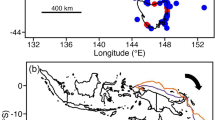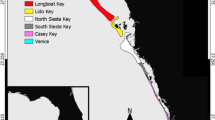Abstract
We present data spanning approximately 100 years regarding the spatial and temporal occurrence of marine turtle sightings and strandings in the northeast Atlantic from two public recording schemes and demonstrate potential signals of changing population status. Records of loggerhead (n = 317) and Kemp’s ridley (n = 44) turtles occurring on the European continental shelf were most prevalent during the autumn and winter, when waters were coolest. In contrast, endothermic leatherback turtles (n = 1,668) were most common during the summer. Analysis of the spatial distribution of hard-shell marine turtle sightings and strandings highlights a pattern of decreasing records with increasing latitude. The spatial distribution of sighting and stranding records indicates that arrival in waters of the European continental shelf is most likely driven by North Atlantic current systems. Future patterns of spatial-temporal distribution, gathered from the periphery of juvenile marine turtles habitat range, may allow for a broader assessment of the future impacts of global climate change on species range and population size.







Similar content being viewed by others
References
Bell CD, Solomon JL, Blumenthal JM, Ebanks-Petrie TJA, Broderick AC, Godley BJ (2006) Monitoring and conservation of critically reduced marine turtle nesting populations: Lessons from the Cayman Islands. Animal Conservation (in press)
Bjorndal KA, Bolton AB, Martins HR (2000) Somatic growth model of juvenile loggerhead sea turtles Caretta caretta: duration of pelagic stage. Marine Ecol Prog Ser 202:265–272
Bolten AB (2003) Active swimmers-passive drifters: the oceanic juvenile stafe of loggerheads in the Atlantic system. In: Bolten AB, Witherington BE (eds) Loggerhead sea turtles. Smithsonian Books, pp 319
Bolten AB, Martins HR (1990) Kemp’s ridley captured in the Azores. Marine Turtle Newsl 43:23
Bolten AB, Martins HR, Natali ML, Thome JC, Marcovaldi MÂ (1990) Loggerhead released in Brazil recaptured in azores. Marine Turtle Newsl 48:24–25
Bolten AB, Bjorndal KA, Santana JC (1992) Transatlantic crossing by a loggerhead turtle. Marine Turtle Newsl 59:7–8
Bolten AB, Martins HR, Bjorndal KA, Gordon J (1993) Size distribution of pelagic-stage loggerhead sea turtles (Caretta caretta) in the waters around the Azores and Maderia. Arquipelago:49–55
Bolten AB, Bjorndal KA, Martins HR, Dellinger T, Biscoito MJ, Encalada SE, Bowen BW (1998) Transatlantic developmental migrations of loggerhead sea turtles demonstrated by mtDNA sequence analysis. Ecol Appl 8:1–7
Boulon R, Dutton P, McDonald D (1996) Leatherback turtles (Dermochelys coriacea) on St. Croix US Virgin Islands: fifteen years of conservation. Chelonian Conserv Biol 2:141–147
Brongersma LD (1972) European Atlantic turtles. Zoologsische Verhandelingen 121:1–318
Brongersma LD (1995) Marine turtles of the Eastern Atlantic Ocean. In: Bjorndal KA (ed) Biology and conservation of sea turtles. Smithsonian Institution Press, Washington, pp 615
Carr A (1986) Rips, fads, and little loggerheads. Bioscience 36:92–100
Carr A (1987) New perspectives on the pelagic stage of sea turtle development. Conserv Biol 1:103–121
Collard SB, Ogren LH (1990) Dispersal scenarios for pelagic post-hatchling sea-turtles. Bull Marine Sci 47:233–243
Coyne MC (2000) Population sex ratio of the Kemp’s ridley sea turtle (Lepidochelys kempii): Problems in population modelling. PhD Thesis
Davenport J (1998) Sustaining endothermy on a diet of cold jelly: energetics of the leatherback turtles Dermochelys coriacea. Br Herpetol Soc Bull 62:4–8
Duguy R (1990) Observations de tortues marines en 1990 (Manche et Atlantique). Annales de la Societe des Sciences Naturelles de la Charente-Maritime 7:1053–1057
Duguy R (1992) Observations de tortues marines en 1991 (Atlantique). Annales de la Societe des Sciences Naturelles de la Charente-Maritime 8:35–37
Duguy R (1993) Observations de tortues marines en 1992 (Atlantique). Annales de la Societe des Sciences Naturelles de la Charente-Maritime 8:129–131
Duguy R (1994) Observations de tortues marines en 1993 (Atlantique). Annales de la Societe des Sciences Naturelles de la Charente-Maritime 8:235–238
Duguy R (1995) Observations de tortues marines en 1994 (Atlantique). Annales de la Societe des Sciences Naturelles de la Charente-Maritime 8:403–406
Duguy R (1996) Observations de tortues marines en 1995 (Atlantique). Annales de la Societe des Sciences Naturelles de la Charente-Maritime 8:505–513
Duguy R (2004) Observations de tortues marines en 2003 (cotes Atlantiques). Annales de la Societe des Sciences Naturelles de la Charente-Maritime 9:361–366
Duguy R, Moriniere P, Meunier A (1997a) Observations de tortues marines en 1997. Annales de la Societe des Sciences Naturelles de la Charente-Maritime 8:761–779
Duguy R, Moriniere P, Spano MA (1997b) Observations de tortues marines en 1996 (Atlantique). Annales de la Societe des Sciences Naturelles de la Charente-Maritime 8:625–632
Duguy R, Moriniere P, Meunier A (1999) Observations de tortues marines en 1998 (Atlantique). Annales de la Societe des Sciences Naturelles de la Charente-Maritime:911–924
Duguy R, Moriniere P, Meunier A (2000) Observations de tortues marines en 1999. Annales de la Societe des Sciences Naturelles de la Charente-Maritime 8:1025–1034
Duguy R, Moriniere P, Meunier A (2001) Observations tortues marines en 2000 (Atlantique et Manche). Annales de la Societe des Sciences Naturelles de la Charente-Maritime 9:17–25
Duguy R, Moriniere P, Meunier A (2002) Observations de tortues marines en 2001 (Atlantique et Manche). Annales de la Societe des Sciences Naturelles de la Charente-Maritime 9
Duguy R, Moriniere P, Meunier A (2003) Observations de tortues marines en 2002 (Atlantique et Manche). Annales de la Societe des Sciences Naturelles de la Charente-Maritime 9:265–273
Eckert SA (1989) Transatlantic travel by juvenile loggerhead turtle. Marine Turtle Newsl 45:15
Ehrhart LM, Bagley DA, Redfoot WE (2003) Loggerhead turtles in the Atlantic Ocean: geographic distribution, abundance, and population status. In: Bolten AB, Witherington BE (eds) Loggerhead seabturtles. Smithsonian Books, Washington, pp 319
Fretey J (1998) Marine turtles of the Atlantic Coast of Africa. Convention on the Conservation of Migratory Species of Wild Animals, Bonn
Godley BJ, Gaywood MJ, Law RJ, McCarthy CJ, McKenzie C, Patterson IAP, Penrose RS, Reid RJ, Ross HM (1998) Patterns of marine turtle mortality in British Waters (1992–1996) with reference to tissue contaminant levels. J Marine Biol Assoc UK 78:973–984
Hasting M (2003) A conservation success: leatherback turtles in the British Virgin Islands. Marine Turtle Newsl 99:5–7
Hawkes LA, Broderick AC, Coyne MS, Godfrey MH, Lopez-Jurado LF, Lopez-Suarez P, Merino SE, Varo-Cruz N, Godley BJ (2006) Phenotypically linked dichotomy in sea turtle foraging requires multiple conservation approaches. Curr Biol 16:990–995
Hays GC, Marsh R (1997) Estimating the age of juvenile loggerhead sea turtles in the North Atlantic. Canad J Zool-Rev Canadienne De Zoologie 75:40–46
Hildebrand HH (1963) Hallazgo del area de anidacion de la tortuga marina “lora”, Lepidochelys kempi (Garman) en la costa occidental del Golfo de Mexico. Ciencia 22:105–112
Hurrell JW (1995) Decadal trends in the North-Atlantic Oscillation—regional temperatures and precipitation. Science 269:676–679
Laurent L, Casale P, Bradai MN, Godley BJ, Gerosa G, Broderick AC, Schroth W, Schierwater B, Levy AM, Freggi D, Abd El-Mawla EM, Hadoud DA, Gomati HE, Domingo M, Hadjichristophorou M, Kornaraky L, Demirayak F, Gautier C (1998) Molecular resolution of marine turtle stock composition in fishery bycatch: a case study in the Mediterranean. Mol Ecol 7:1529–1542
Márquez R (1990) Sea turtles of the World. Food and agriculture organization of the United Nations, Rome
Márquez R, Díaz J, Sánchez M, Burchfield P, Leo A, Carrasco M, Peña J, Jiménez C, Bravo R (1999) Results of the Kemp’s Ridley Nesting Beach conservation efforts in México. Marine Turtle Newsl 85:2–4
McMahon CR, Hays GC (2006) Thermal niche, large-scale movements and implications of climate change for a critically endangered marine vertebrate. Global Change Biology 12:1–9
Mills CE (2001) Jellyfish blooms: are populations increasing globally in response to changing ocean conditions? Hydrobiologia 451:55–68
Musick JA, Limpus CJ (1997) Habitat utilization and migration in juvenile sea turtles. In: Lutz PL, Musick JA (eds) The biology of sea turtles. CRC Press, Boca Raton, pp 432
Penhallurick R (1990) Turtles off Cornwall, The Isles of Scilly and Devonshire. Dyllansow Pengwella
Penrose RS (2005) UK & Eire Marine Turtle Strandings & Sightings Annual Report 2004. Marine Environmental Monitoring
Rayner NA, Parker DE, Horton EB, Folland CK, Alexander LV, Rowell DP, Kent EC, Kaplan A (2003) Global analyses of sea surface temperature, sea ice, and night marine air temperature since the late nineteenth century. J Geophys Res-Atmos 108
Schwartz F (1978) Behavioural and tolerance responses to cold water temperature by three species of sea turtles (Reptilia, Cheloniidae) in North Carolina. Florida Marine Res Publ 33:16–18
Shaver DJ, Amos AF, Higgins B, Mays J (2005) Record 42 Kemp’s Ridley nests found in Texas in 2004. Marine Turtle Newsl 108:1–3
Still B, Griffin C, Prescott R (2005) Climatic and oceanographic factors affecting daily patterns of juvenile sea turtle cold-stunning in Cape Cod Bay. Chelonian Conserv Biol 4:883–890
Troeng S, Chacon D, Dick B (2004) Possible decline in leatherback turtle Dermochelys coriacea nesting along the coast of Caribbean Central America. Oryx 38:395–403
TWEG (2000) Assessment update for the Kemp’s ridley and loggerhead sea turtle populations in the western North Atlantic. National Marine Fisheries Service, NMFS-SEFSC-444, Miami
Wibbels T (1983) A Transatlantic movement of a headstarted Kemp’s ridley. Marine Turtle Newsl 24:15–16
Witherington BE (2002) Ecology of neonate loggerhead turtles inhabiting lines of downwelling near a Gulf Stream front. Marine Biol 140:843–853
Witt MJ, Broderick AC, Johns DJ, Martin C, Penrose R, Hoogmoed MS, Godley BJ (2006) Prey landscapes help identify potential foraging habitats for leatherbacks turtles in the northeast Atlantic. Mar Ecol Prog Ser (in press)
Zwinenberg AJ (1977) Kemp’s ridley, Lepidochelys kempii (Garmin, 1880), undoubtedly the most endangered marine turtle today (with notes on the current status of Lepidochelys olivacea). Bull Maryland Herpetol Soc 13:170–192
Acknowledgments
We are indebted to Dr Duguy for his annual publications on marine turtles in French waters and to the members of public for the reporting of sightings, strandings and captures of marine turtles in the British Isles and France. We thank M Godfrey, C McLellan, S Murphy and B Witherington for discussions during drafting of this manuscript. We show appreciation to J Braun-McNeil, L Avens and M Coyne for access to morphometric data on Kemp’s ridley and loggerhead turtles. We are especially grateful to A Broderick, M Godfrey, M Coyne, C Bell, J Blumenthal and L Hawkes for comments on earlier drafts of this manuscript. We would like to thank two anonymous reviewers for constructive criticism that lead to an improvement of this manuscript. TURTLE, operated by Marine Environmental Monitoring, receives financial support from Scottish Natural Heritage, English Nature, and the Countryside Council for Wales. This analysis was supported by grants to BJG from the Natural Environment Research Council (NERC), Darwin Initiative, and UK Overseas Territories Environment Programme. MJW is funded by a NERC PhD studentship (NER/S/A/2004/12980) at the University of Exeter, Cornwall Campus.
Author information
Authors and Affiliations
Corresponding author
Additional information
Communicated by P.W. Sammarco, Chauvin.
Rights and permissions
About this article
Cite this article
Witt, M.J., Penrose, R. & Godley, B.J. Spatio-temporal patterns of juvenile marine turtle occurrence in waters of the European continental shelf. Mar Biol 151, 873–885 (2007). https://doi.org/10.1007/s00227-006-0532-9
Received:
Accepted:
Published:
Issue Date:
DOI: https://doi.org/10.1007/s00227-006-0532-9




